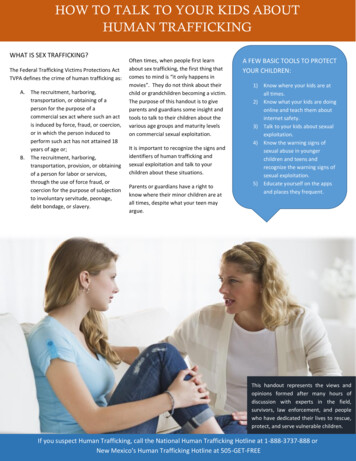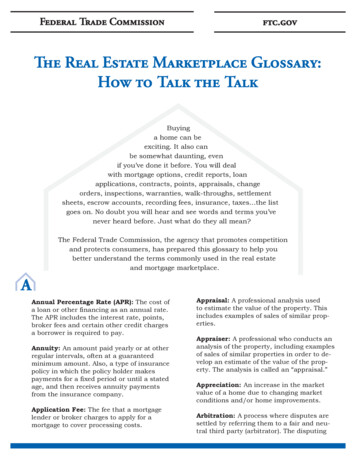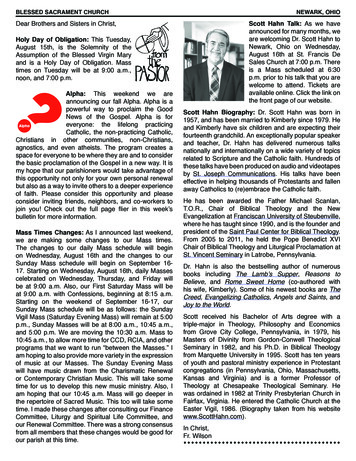
Transcription
HOW TO TALK TO YOUR KIDS ABOUTHUMAN TRAFFICKINGWHAT IS SEX TRAFFICKING?The Federal Trafficking Victims Protections ActTVPA defines the crime of human trafficking as:A. The recruitment, harboring,transportation, or obtaining of aperson for the purpose of acommercial sex act where such an actis induced by force, fraud, or coercion,or in which the person induced toperform such act has not attained 18years of age or;B. The recruitment, harboring,transportation, provision, or obtainingof a person for labor or services,through the use of force fraud, orcoercion for the purpose of subjectionto involuntary servitude, peonage,debt bondage, or slavery.Often times, when people first learnabout sex trafficking, the first thing thatcomes to mind is “it only happens inmovies”. They do not think about theirchild or grandchildren becoming a victim.The purpose of this handout is to giveparents and guardians some insight andtools to talk to their children about thevarious age groups and maturity levelson commercial sexual exploitation.It is important to recognize the signs andidentifiers of human trafficking andsexual exploitation and talk to yourchildren about these situations.Parents or guardians have a right toknow where their minor children are atall times, despite what your teen mayargue.A FEW BASIC TOOLS TO PROTECTYOUR CHILDREN:1) Know where your kids are atall times.2) Know what your kids are doingonline and teach them aboutinternet safety.3) Talk to your kids about sexualexploitation.4) Know the warning signs ofsexual abuse in youngerchildren and teens andrecognize the warning signs ofsexual exploitation.5) Educate yourself on the appsand places they frequent.This handout represents the views andopinions formed after many hours ofdiscussion with experts in the field,survivors, law enforcement, and peoplewho have dedicated their lives to rescue,protect, and serve vulnerable children.If you suspect Human Trafficking, call the National Human Trafficking Hotline at 1-888-3737-888 orNew Mexico’s Human Trafficking Hotline at 505-GET-FREE
WHERE IS YOUR CHILD RIGHT NOW?As a parent or guardian, you may have varying degrees of apprehension about giving your child enough freedomnecessary to grow up and become an adult. In today’s world, it is perfectly acceptable to have fears about yourchild’s safety, especially when it is nearly impossible to keep up with teens’ latest social media trends.ONLINE BEHAVIORS IN KIDSAND TEENSThe latest Harvard research suggests that 9 in 10 (93 %) of teens have a computeror have access to one at home. Although it may be hard to believe, tech savvy kidsas young as 5 are now actively using and engaging in social media.Kids online are exploring various websites, emailing friends, chatting with friendsthrough instant messenger and in chat rooms, sending each other pictures andvideos, playing games together online, creating websites and web blogs, andsearching YouTube for popular “viral” videos and trends.One thing is certain—Nearly all teens have a cell phone, and mostteens cannot function without their cellphone on hand. Accordingto report released in March 2013 by Harvard University entitled“Teens and Technology 2013” 78% of teens now have a cell phone.In present day, I would bet you that the percentage has increasedto 90-90%.Cell phone tracking can help you locate your child’s lost cell phone,and can help keep you notified of your child’s whereabouts at alltimes; especially in the event of an emergency. Most cell phonecarriers have programs to assist parents with this task.Major wireless service providers such as “AT&T, Verizon, and Sprintoffer “Family Locator” packages that allow you to locate and trackthe cell phones on your plan. In addition to that, if your child’sphone has GPS capabilities, you can download a tracking appdirectly from the phone.Predators and traffickers prey upon children who have thefreedom to move around freely without suspicion. Children whoare most vulnerable are those who do not have a parent orguardian looking for them—often times these children arerunaways.Some research points to direct parallels between socio-economicfactors and risk for trafficking. Children who are raised in povertyor come from the foster care system are far more likely to fallvictim to predators.Your child must be taught never to give any personal information,answer questions such as birthdate or social security numbers, orfill out forms online.Today’s parents are navigating uncharted parenting territory. Thegood news is that most dangers can be avoided if children and theirparents learn about smart internet use.Be sure to place any computer your younger child uses in a common area, so youcan monitor what is happening. Pre-teens should never be allowed on chat siteswithout supervision. For older teens, parents should have the right to ask aboutbrowsing history and access to all passwords.When discussing social networking safety with your teen, encourage them to alwaysuse discretion when posting any type of photo, location, status, and message.Teens tend to over share information. They post questionable photos, give theirlocations and share personal information such as their cell phone numbers andhome address. What seems like harmless chatter between friends can end uppinpointing your child’s location and regular behavior to a predator.Traffickers and predators are masterful at deception and gaining a teen’strust online first, before meeting online.KNOW WHAT YOUR KIDS ARE DOINGONLINEAnother way to keep tabs on your kids is to follow them on their social media sites.You may learn a lot about your child from how he or she communicates with peers.Teens should interact with only people they know. Allowing only people you knowand trust as “friends” or “followers” is the best way to ensure safety when usingsocial networking sites. Unfortunately, some teens are motivated by sheer volumein the numbers of online “followers”, and fail to think about the dangers associatedwith a stranger having access to personal information such as photos and locations.Learning how to use social media apps like Instagram, Snapchat, Facebook, andTwitter are becoming part of “good” parenting today. Everyone can learn how touse social media—just ask your child to teach you or visitwww.commonsensemedia.com to get more information on what kids are usingtoday and how to monitor their apps.If you suspect Human Trafficking, call the National Human Trafficking Hotline at 1-888-3737-888 orNew Mexico’s Human Trafficking Hotline at 505-GET-FREE
TALK TO YOUR CHILDREN ABOUT EXPLOITATIONAND HUMAN TRAFFICKINGTEACH YOUR CHILDREN TOTRUST THEIR INSTINCTSWHEN DO I START THECONVERSATION?With so much constant change in the internet space, the best way toequip a child is to teach them to trust their instincts. If something feelswrong, it probably is. If something seems too good to be true, itprobably is.Human sexuality is not openly discussed in many American households,yet the topic is glaringly present in all aspects of media seen by kids andteens on a daily basis. These are difficult waters for a child to navigatealone.TALK TO YOUR CHILDRENMost kids under the age of 10 are usually naïve about sexuality and havelimited knowledge about sex, and even more limited understanding ofrape or sexual exploitation.Slavery is a common topic taught in schools and most kids believe thatslavery ended with the Emancipation Proclamation of 1863, or threeyears later with the ratification of the Thirteenth Amendment. Kids canrelate to the concept of slaves having to work without pay and nothaving the freedom to escape the situation. This is a logical way toaddress the topic of commercial sexual exploitation. You can share thefact that there are more slaves today worldwide than at any other timeduring history. For more resources, The New York public school systemhas an excellent curriculum about modern day /sanctuary-nyc-2013.pdfHuman growth and development at school likely occurs during the 5 thgrade, when students range from ages 9-11. In girls, puberty usuallystarts around 11 years of age and in boys puberty usually starts around12 years of age. The normal onset of puberty ranges in girls from 9-16while in boys it is 12-15.It is best to have these conversations with your children after puberty hasbegun.Pre-pubescent children lack the physical and mental maturity tounderstand changes in the human body that prepare them for sexualreproduction.It is important to understand that girls who mature early may beginsexual activity earlier than those who physically mature at a slower pace.STRANGER DANGERWhere student may learn about reproductive health at school, it is upto the family to teach their kids to feel good about how their bodies lookand feel. Parents can teach children at a young age about physical touchand what is appropriate and what is inappropriate. Children should betaught what kind of touch is acceptable, what to do if someone tries tohurt them, and that is okay to talk about anything that makes them“feel” uncomfortable with a parent, guardian, or responsible adult.Despite sensational media coverage, stranger abductions are extremelyrare. According to the National Center for Missing and ExploitedChildren, only 115 children per year in this country are victims of“stereotypical” kidnappings, where a stranger takes a child to keep orharm them. Young children are less likely to be targeted by strangersthan teens.Nevertheless, it is important to talk to your children about strangers andabove all, teach them to once again trust their own instincts. Childrenshould never be left alone with unknown adults and should alwaystravel in groups, where there is safety in numbers.If you suspect Human Trafficking, call the National Human Trafficking Hotline at 1-888-3737-888 orNew Mexico’s Human Trafficking Hotline at 505-GET-FREE
SEXTING AND SEXTORTIONAs a parent or guardian, it is extremely important to know if your child is engaging in these activities. Even if yourchild denies being involved in these activities, ensure that your talking to them about how these practices canaffect their life and their reputation.WHAT IF .“What if?” questions are an opportunity to practice scenarios with your kids. Roleplaying is a powerful way to teach kids how to handle difficult situations.Act out with your child various situations at different familiar locations—sportspractice, walking to a friend’s house, outdoor festivals, Halloween, at the mall, MovieTheater, etc.These “what would you do” conversations can take place at the dinner table or onthe drive to school and may help ease apprehension about the topic.You will probably hear, “Oh Mom, Seriously?” In the end, it is better to upset yourchild so that he or she thinks twice when potentially faced with a difficult situation.WHAT IS SEXTING?“What would you do if a good looking olderguy came up to you at the mall and said hethought you were pretty enough to be amodel?”“Would you give him your phone number?”“Is it okay for a stranger to take pictures ofyou?”“Is it okay to send pictures of yourself to astranger?”“Have you ever known someone at schoolthat had an older boyfriend?”“Have any of your friends ever talked aboutgetting paid to go on a date?”“Do you know what sexting is?”“Has anyone ever sent you a picture thatmade you feel uncomfortable?”Questions to ask your teen or another way to begin aconversation with your teen. When you askquestions, you show that you care about your kid’shealth and safety.Sexting is the sending of sexually explicit photos or text through ones mobile phoneto another person. Sexting is more common than you think. Did you know that 20%of middle schoolers have reported having received sexually explicit messages? 11 % of teens admit they’ve sent images to strangers 80% of teens who have sexted are under the age of 18 12% of teen girls feel pressured to sextTeens sext due to the following reasons: Teen may see sexting as the first step to becoming sexually active It is commonly done in a romantic relationship Many teen see this is as a good way to tell someone that they are interestedin themOther reasons for sexting: Everyone else is doing it To boost self-esteem The need for instant gratification Exploring their sexuality and feelings Finding attention from someone else or gain popularity on social media It is becoming the normal way of flirting among teensWHAT IS SEXTORTION?Sextortion is a criminal and deviant activity by which adolescents and adults exploit otherchildren and adults for sex and/or sexually themed activities in exchange for not disclosingembarrassing and humiliating information. If the victim does not submit to their sexualdirectives, they threaten to disclose sensitive information to loved ones, employers,educators, peers or organizations if the victim does not engage in sexually illicit acts.A study conducted in New Hampshire with 1,600 participant’s concluded that: 46 % were minors Three out of five (60%) knew their perpetrator in real life ; 40 % met themonline 54 % met on social media apps; 41 % met on messaging apps 45 % of perpetrators carried out their threatSEXTING AND SEXTORTION CAN LEAD TO COMMERCIAL SEXUAL EXPLOITATIONIf you suspect Human Trafficking, call the National Human Trafficking Hotline at 1-888-3737-888 orNew Mexico’s Human Trafficking Hotline at 505-GET-FREE
KNOW THE WARNING SIGNS AND AFFECTS OFEXPLOITATIONAccording to national statistics, most children who are trafficked have ahistory of sexual abuse from earlier in their childhood. According toresearch out of the University of Pennsylvania School of Social Work,nationally, 95% of “teen prostitutes” were victims of earlier childhoodsexual abuse. Noticing the warning signs of abuse can help thesechildren receive the services they need to so they are not furthervictimized or exploited.Homeless, runaway/throwaway and foster children are the mostvulnerable population of kids that are at risk for sex trafficking.According to researchers out of Arizona State University’s Office of SexTrafficking Intervention and Research, vulnerable girls may berecruited “into the life” by friends or over the internet. Pimps often actas a boyfriend. They might befriend a victim or require one of theircurrent victims to befriend a new girl.YOUNGER CHILDRENTEENS Gradual or sudden changes in behaviorCruelty to othersCruelty to petsRecurring nightmaresDisturbed sleep patternsFear of the darkRegression behavior like bed wettingUnusual interest in/ knowledge of sexExpressing affection in ways that are inappropriate for a childof that ageSexual Acting Out/ Inappropriate sexual play (with self, otherchildren)Fear of a certain person/ intense dislike of being leftsomewhereChange in behavior around a specific personAfraid to be left aloneLoss of or lack of interest in friends, school sports, or otheractivitiesFear of participating in physical activities at school Extreme and/ or unexplained angerRunning awayLow self-esteemSelf-destructive behaviors/ self harmSeductive behaviorPromiscuous behaviorEating disordersAnxiety and/ or DepressionAlcohol or substance abuse at young ageDifficulty establishing relationships with family members andpeers at schoolSigns of PTSD from prior traumaSexually Transmitted DiseasesInadequately dressed for schoolTeens carrying large amounts of cash with no probable way ofobtaining itMultiple sexual partners at a young ageConstantly running away from homeOften using their friends as “cover-ups” for their whereaboutsIf you suspect Human Trafficking, call the National Human Trafficking Hotline at 1-888-3737-888 orNew Mexico’s Human Trafficking Hotline at 505-GET-FREE
NEW MEXICO HUMAN TRAFFICKING TASK FORCEAs a parent or guardian, you have the right to know about agencies that can offer resources and services to teenswho have been sexually exploited or if your child’s image is online.New Mexico’s human trafficking statute was enacted in 2008, which wasspearheaded by the New Mexico Office of the Attorney General (NMOAG).Since then, the task force has been involved in intensive public awarenesscampaigns and statewide training efforts. There has been a dramaticincrease in identified human trafficking cases. These human trafficking casesare multi-faceted, often involving labor exploitation, sexual exploitation,domestic violence, pornography, door-to-door sales crews, escort services,truck stops (sex trafficking), human smuggling, gang activity, drug trafficking,and money laundering. Effective enforcement requires a coordinated,collaborative, multi-disciplinary approach to investigate these diverseaspects of criminal conduct. We are a statewide task force. We addresstrafficking issues not only in our metropolitan area, but in other cities and allother areas of the state.CONTACT USNew Mexico Office of the Attorney GeneralHuman Trafficking Unit/ ICAC Unit201 Third St. NW, Suite 300Albuquerque, NM 87102(505) 717-3500New Mexico Human Trafficking Task Forcewww.stopnmtrafficking.orgHuman Trafficking Hotlines:Polaris BeFree Textline233733National Human Trafficking Hotline1-(888)-373-7888NM Hotline505-GET-FREEWe can answer questions on human trafficking,child sex trafficking, sexting, sextortion, cybersafety and Internet Crimes against Children. Wecan refer you to services and assist with lawenforcement investigations.The NMOAG, USAO, and The Life Link have established a collaborativepartnership working together and with other key stakeholders to investigatehuman trafficking cases, provide services to victims and increase awarenessof human trafficking. Key stakeholders include all levels of law enforcement,the justice system, state/ local government, service providers,medical/health field, schools, media, and community resources.This multidisciplinary task force brings a collaborative and concentratedapproach to proactive investigations and prosecutions of all types of humantrafficking.Our primary objectives consist of:1) Conducting proactive investigations of sex trafficking and labor traffickingcrimes in coordination and collaboration with local, state, tribal, regional,and federal law enforcement and regulatory agencies.2) Identify victims of all forms of human trafficking and offer acomprehensive array of restorative services to meet each victim hasindividualized needs.3) Enhance community capacity to identify and report trafficking crimes byconducting training, public awareness, and outreach.Through the tremendous efforts of our task force partners, we have been successfulin prosecuting these cases and bringing restorative justice to those who have beenvictims of this heinous crime. With your help, we can combat human trafficking in NewMexico and save the lives of many men, women, and children who have yet to bevictimized.If you suspect Human Trafficking, call the National Human Trafficking Hotline at 1-888-3737-888 orNew Mexico’s Human Trafficking Hotline at 505-GET-FREE
TALK TO YOUR CHILDREN ABOUT EXPLOITATION AND HUMAN TRAFFICKING If you suspect Human Trafficking, call the National Human Trafficking Hotline at 1-888-3737-888 or New Mexico’s Human Trafficking Hotline at 505-GET-FREE TEACH YOUR CHILDREN TO TRUST THEIR INSTINCTS With so mu











